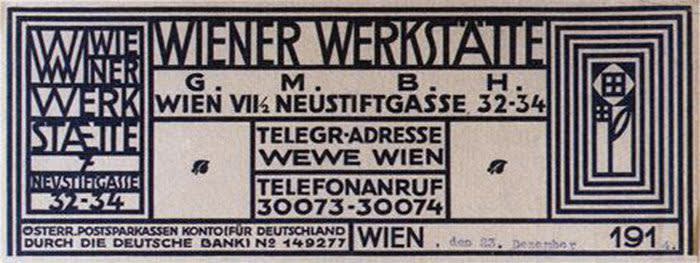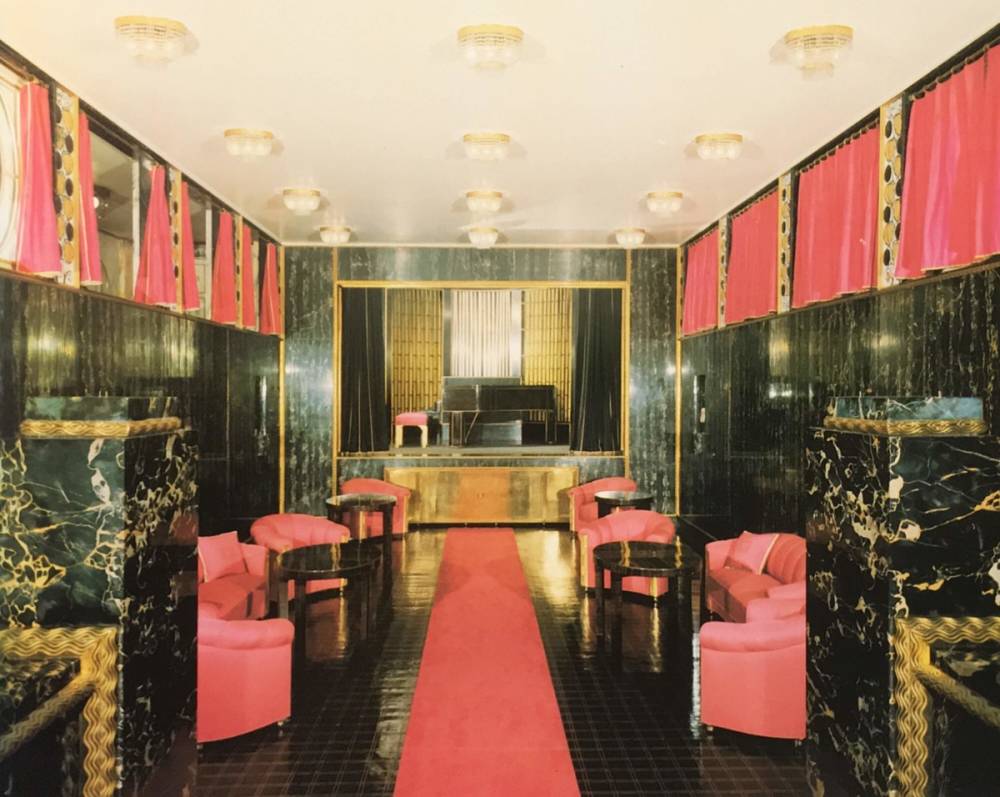
Josef Hoffmann and The Wiener Werkstätte
Palais Stoclet, 1905
Wiener Werkstätte, what many consider the original design firm, began in 1903 as the brainchild of Josef Hoffman and Koloman Moser. A product of Vienna’s “Secession” movement, which included artists like Gustav Klimt, the Wiener Werkstätte broke away from the stylistic revivals that dominated Austrian architecture and design throughout the 19th century. The Secession movement was centered in the Austrian capital and displayed features in context with both traditional methods of manufacturing and distinctly avant-garde aesthetics. The movement produced an array of skilled craftsmen and a complex network of production and distribution that forged a standard for Austrian design.
As the movement forged a new degree of excellence associated with Austrian design, Werkstätte heavily emphasized ideals surrounding complete artistic freedom. This resulted in a plethora of output/designs between the dawn of the century and The Great Depression. The firm even coined the term Gesamtkunstwerk, or “total work of art,” in which they sought to create a unified aesthetic across an entire designed environment. The Wiener Werkstätte also proved innovative in their desire to create linking points between their varrying activities. For example, Werkstätte created postcards which often featured the Workshops’ output in architecture, textiles, fashion, glass and ceramics. It was this move that helped the firm attain two of its goals: first, narrowing the gap in prestige between artistic genres; and second, bolstering the commercial visibility of its designs.
Koloman Moser
Original Design for Opening of Wiener Werkstätte Showroom, 1905
Wiener Werkstätte
Postcard, Interlocking 'WW' Logo, 1907
The Wiener Werkstätte firm was the first organization in Austria dedicated to the production of modern decorative arts. Translated in English as the “Viennese Workshops,” the name Wiener Werkstätte represents the broader nature of the organization. Werkstätte incorporated the craft-based production of decorative arts in a mostly rural community, which was historically concentrated in its primary metropolis. Though its artists made ample use of new industrial materials, they resisted temptations to completely turn to mass production. In particular, the firm was especially influenced by the Arts & Crafts and Art Nouveau movements. Unlike other contemporaneous movements throughout decorative arts and design, the Wiener Werkstätte did not seek to create an art that would be accessible to all. Instead, the group focused on the highest quality of craftsmanship and materials targeted for an elite class. Somewhat ironically, the elite went on to treat its work more like artistic objects then utilitarian items.
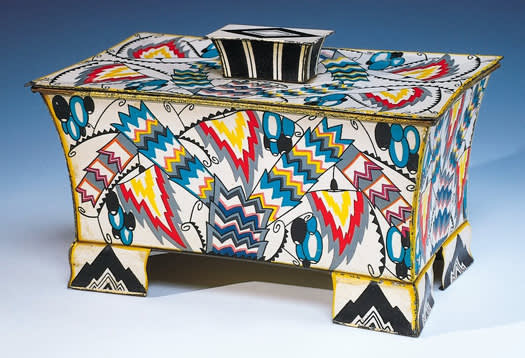
Emanuel Josef Margold
Biscuit Box, 1925
Obsessed with fine art and elevated craftsmanship, the Wiener Werkstätte was eventually unable to produce enough products to keep up with the market's demand. In addition, because of their premier pricing and attention to the highest level quality, mass production was a definite faux pas. The artistry of the Wiener Werkstätte always took primacy over the commercial bottom line of the enterprise, and its reliance on wealthy underwriters to sustain its activities contributed to its gross financial insolvency. However, this inability and lack of desire to mass produce would eventually mark the firm’s downfall. But despite their eventual demise, the firm left deep roots in grounding what would later become known as modernism.
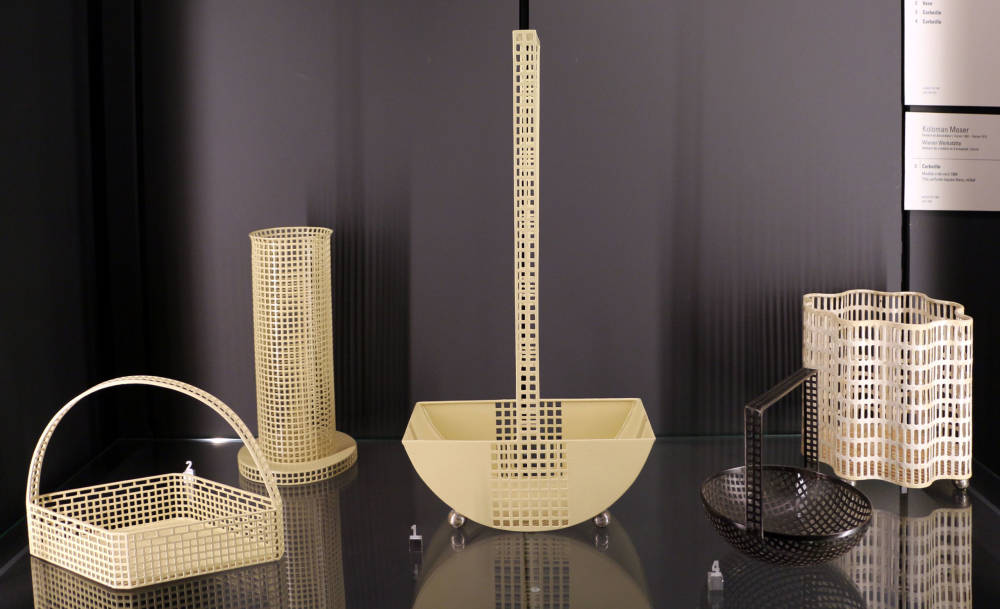
Wiener Werkstätte
Josef Hoffman Hoffmann Designs, 1904-1907

Wiener Werkstätte
Josef Hoffmann, Five Pieces from the 'Flat Model' Flatware Set, 1904–08
Beginning with the 14th Exhibition of the Vienna Secession in 1902, the radical distinctiveness - which became known as Wiener-Werkstätte-Stil - prompted Viennese artists to emerge. In fact, this set a foundation for the widespread Art Deco movement of the latter decades. Josef Hoffman and his cubist sculpture created in 1902, marked a break into independence for many Viennese artists. Hoffman’s work from this period is especially remarkable when considering that the term “cubism” was only incorporated into art lexicon around 1907. Even though some members separated from the Vienna Secession, they continued to collaborate on numerous subsequent projects, ultimately displaying stylistic features indicative of the Wiener Werkstätte oeuvre.

Josef Hoffmann
Untitled, Cubist Sculpture, 1902
The stylistic features that defined the Wiener Werkstätte were varied yet all in sync with one another. Glass bowls, vases, plates and various other objects became exceedingly popular in their design repertoire. This consequently spurred the revival of ceramic bowls, sculptures and dishes as modes of secondary production to the more popular glass making technique. Diana Kuhn, trained by Josef Hoffmann, was known as one of the leading female ceramicists of early 20th century Vienna; she designed ceramics for the Wiener Werkstätte until the mid 1920s. Her stylistic aesthetic dismissed function and practicality, therefore justifying her desire to root her glass and ceramics in decorative ideals.
Josef Hoffmann
Wiener Werkstätte, Etched Glass Vase, 1910s
Josef Hoffmann
Wiener Werkstätte, Vase, 1911
Wiener Werkstätte
Glass Bowl, 1920s
Dina Kuhn
Wiener Werkstätte, Das Wasser Ceramic Head
Wiener Werkstätte was also involved in jewelry, adornment, textiles and fashion. Emilie Louise Flöge, an Austrian fashion designer and businesswoman, in addition to the life companion and muse of artist Gustav Klimt, worked with her sister, Pauline, to create fashion garments in connection with Werkstätte. It was at their atelier that the loose, flowing gowns, portrayed in Klimt’s paintings, were first realized. Most of these iconic fabrics were made and woven by the Wiener Werkstätte themselves. These versatile textiles were originally inspired by Japanese art and designed to be applied to furnishings, wall-paper, curtains, clothing, and sometimes even wrapping papers. The Gesamtkunstwerk approach, in particular, encouraged such versatile designs and means of use.
As the firm's fashion and textile division gained attention, this traction prompted the creation of new segments of the movement, including a special section dedicated to blouse design and construction. Werkstätte’s printed fabrics featured geometric compositions as well as colors and shapes inspired by the more temporal aspects of the natural world. In many of the surviving samples, order and chaos coexist in floral designs reduced to the simplest representational shapes, while forests of repeated forms swarm over the surface of silk swatches.
Wiener Werkstätte
Portrait of Emilie Floge, Wearing Self Made Dress
Wiener Werkstätte
Emilie Floge, Wearing Self Made Dress
Wiener Werkstätte
Dress, Slik Print by Josef Hoffmann, 1924
Wiener Werkstätte
Josef Hoffmann, Eggs Print, Textile Sample, 1907-08
Wiener Werkstätte
Gustav Klimt, Textile Sample, 1920
Wiener Werkstätte
Gustav Klimt, Textile Sample
In addition to Werkstätte’s interest in design, textiles and fashion, both Kolomon Moser and Josef Hoffman had an affinity for precious adornments; as such, miniature jeweled masterworks were a key output for the firm. These wearable works of art were among the most coveted designs produced by the Wiener Werkstätte and were marked with exclusivity, made mostly as custom pieces. Hoffmann’s square brooches were highly regarded, even begging comparison to Gustav Klimt’s canvases. These small treasures are extremely rare today and strongly represent the innovative, all-encompassing ideals of the Wiener Werkstätte.
Wiener Werkstätte
Koloman Moser, Necklace, 1904
Wiener Werkstätte
Josef Hoffmann Pendant with Necklace
Wiener Werkstätte
Josef Hoffmann, Brooch, 1904
Wiener Werkstätte
Josef Hoffmann Tobacco Case, 1912
In addition to household items and jewelry, the Wiener Werkstätte was also involved in fine art, design and architecture. In particular, The Palais Stoclet represents the ultimate, all encompassing environment envisioned by the Wiener Werkstätte. The commission was initiated right as Hoffmann had formally ended his architectural practice with the activities of Werkstätte. Hoffman’s design of the house was centered around the maximization of the two long facades. With a formal, covered pathway leading into the main entrance, and a rear opening into a park, the facades boast multiple levels of terraces which facilitate several different views of the exterior landscape. The greater importance of the Palais Stoclet, however, is the interior which Hoffmann and other artists adorned with expensive commodities such as gold, precious stones, rare woods, leather and marble. The most notable space within the house is the dining room, where there are several portraits of the group’s most enthusiastic patrons, all created by Gustav Klimt. Klimt designed a mural that wraps around three separate walls and displays a sprawling tree of life motif, flanked on one side by a woman and the other by a couple in an embrace. The characteristic panels of gold and other colors almost dissolve the figures into an abstraction that mimics the geometric patterns and panels encompassed by the remainder of the room, including the furniture. The angularity, regularity, and severity of the geometrics inside the house, combined with the luxurious taste of the client, suggests the move towards a craft-like, nearly Cubist ostentation that forecasted the emergence of Art Deco.
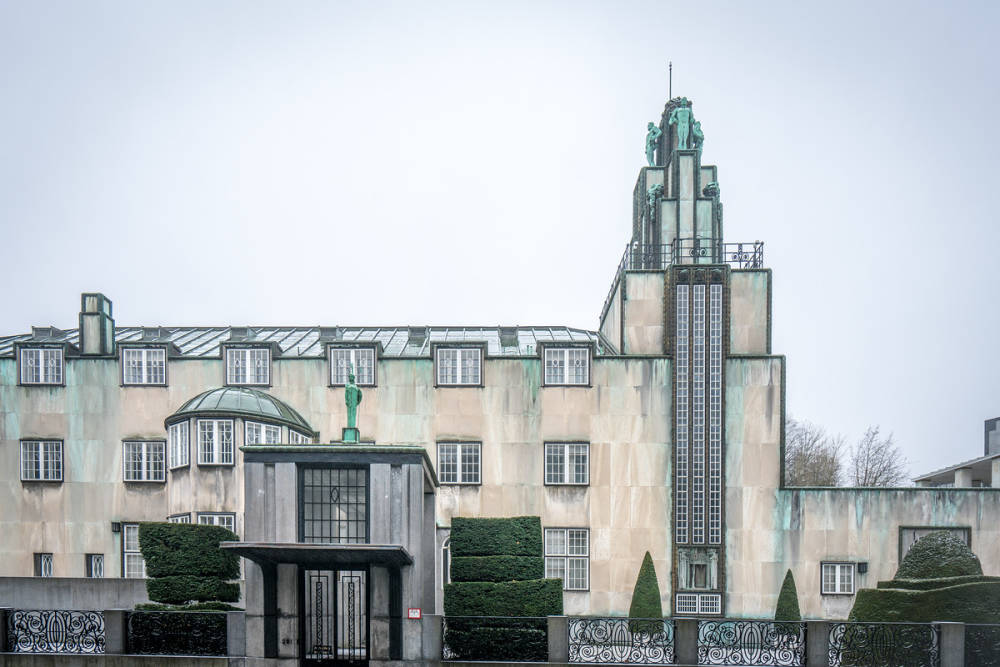
Josef Hoffmann and Wiener Werkstätte
Palais Stoclet, 1905
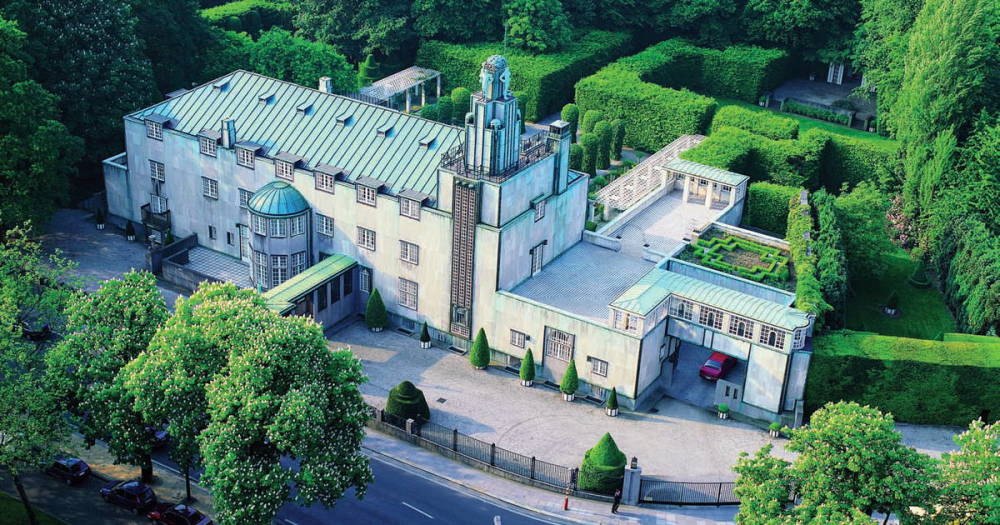
Josef Hoffmann and Wiener Werkstätte
Palais Stoclet, 1905

Josef Hoffmann and Wiener Werkstätte
Palais Stoclet, 1905
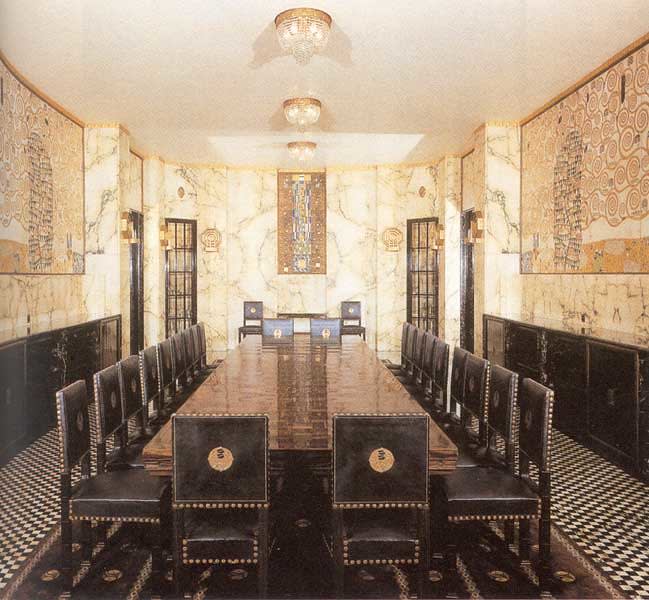
Josef Hoffmann and Wiener Werkstätte
Palais Stoclet, 1905
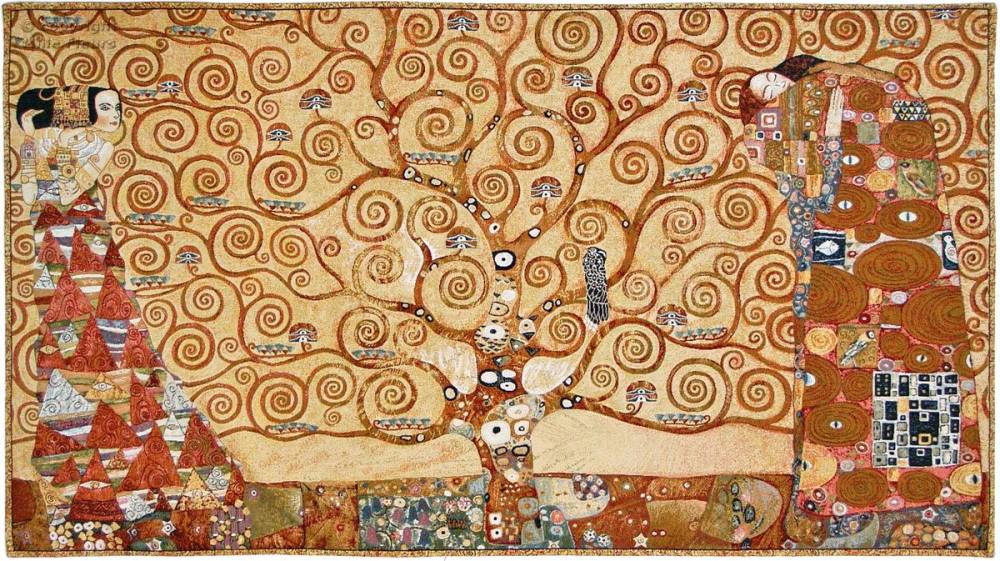
Gustav Klimt
Palais Stoclet, Mural in Dining Room
In regards to decorative arts, Josef Hoffmann created the Sitzmaschine chair in 1905, which went on to become the best known piece of furniture produced by the Wiener Werkstätte. The Sitzmaschine or “sitting machine” was originally designed by Hoffmann for the Purkersdorf Sanatorium, an equalized hospital/spa resort. Its significance lies in its genuine disclosure of function and construction, without the sacrifice of aesthetic appeal. The legs and arms of the chair unite in dramatic curves which are almost suggestive of wheels of a machine in motion. Though the chair is pierced by gridded and slit-like openings, none of the lines or edges end in sharp corners, they are instead rounded, further underscoring the notion of a well-oiled, harmonious machine. This exhibition of function, meanwhile, is evident in the set of balls on the back of the arms, which support a transverse bar behind the back and can be adjusted for different gradations of reclining. The chair’s association with the machine is further extended through its materiality, as it uses bentwood for the curved pieces, a significant instance where the Wiener Werkstätte proved to be attentive to the didactics of mass production. This, in fact, represents a specific moment in which Austria could claim technological innovation, as the process for making bentwood was perfected in the 1830s by Micheal Thonet, a German manufacturer who moved his operations to Vienna in 1842. The Werkstätte outsourced the manufacturing duties for this chair to Jacob and Josef Kohn’s firm, which, along with Thonet, was one of the primary companies used by the Werkstätte for furniture production. Nonetheless, for all its associations with utility, the chair is notorious for being anything but comfortable. The Sitzmachine therefore reflects the nature of Hoffmann’s design practice, wherein function was usually sacrificed to aesthetics when it became impossible to accommodate both.
Josef Hoffmann
Sitzmaschine Chair, 1905
Josef Hoffmann
Sitzmaschine Chair, 1905
Josef Hoffmann
Sitzmaschine Chair, 1905
The Wiener Werkstätte ethos can be most readily expressed through the modernity of their letterhead, created in 1904 by Kolomon Moser. The bold geometry, clean lines and simplified typeface of the Werkstätte motif differentiated it from other organizations who focused on intricate pictorial graphics. Individual sections of the design are dictated by an overarching, repetitive set of boxes and borders, which use the same line weights as the arms of the sans-serif lettering. A notable feature can be seen at the top left, where the interlocking “WW” logo resembles the fluidity and intentionality of our own “MM” logo. The design employs a regimented order that mimics the uses of form in manual printing-press typesetting. This is highly appropriate, as it arguably references the hybrid-like manner in which the Werkstätte functioned as a massive, craft-based workshop that nonetheless could not completely escape the use of mechanized production. Even nature itself, as suggested by the flower-esque bloom on the right side of the letterhead, is abstracted in form. The Wiener Werkstätte letterhead therefore is increasingly indicative of the overall spirit of the firm, as its voluntary design both transcends nature and converses with it.
